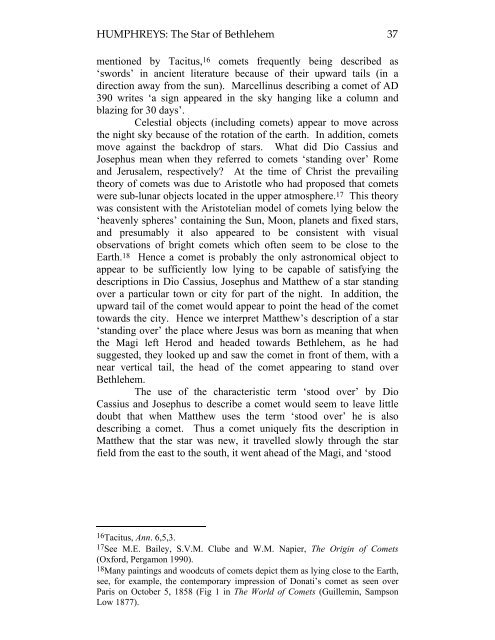THE STAR OF BETHLEHEM, A COMET IN 5 BC ... - Tyndale House
THE STAR OF BETHLEHEM, A COMET IN 5 BC ... - Tyndale House
THE STAR OF BETHLEHEM, A COMET IN 5 BC ... - Tyndale House
Create successful ePaper yourself
Turn your PDF publications into a flip-book with our unique Google optimized e-Paper software.
HUMPHREYS: The Star of Bethlehem 37<br />
mentioned by Tacitus, 16 comets frequently being described as<br />
‘swords’ in ancient literature because of their upward tails (in a<br />
direction away from the sun). Marcellinus describing a comet of AD<br />
390 writes ‘a sign appeared in the sky hanging like a column and<br />
blazing for 30 days’.<br />
Celestial objects (including comets) appear to move across<br />
the night sky because of the rotation of the earth. In addition, comets<br />
move against the backdrop of stars. What did Dio Cassius and<br />
Josephus mean when they referred to comets ‘standing over’ Rome<br />
and Jerusalem, respectively? At the time of Christ the prevailing<br />
theory of comets was due to Aristotle who had proposed that comets<br />
were sub-lunar objects located in the upper atmosphere. 17 This theory<br />
was consistent with the Aristotelian model of comets lying below the<br />
‘heavenly spheres’ containing the Sun, Moon, planets and fixed stars,<br />
and presumably it also appeared to be consistent with visual<br />
observations of bright comets which often seem to be close to the<br />
Earth. 18 Hence a comet is probably the only astronomical object to<br />
appear to be sufficiently low lying to be capable of satisfying the<br />
descriptions in Dio Cassius, Josephus and Matthew of a star standing<br />
over a particular town or city for part of the night. In addition, the<br />
upward tail of the comet would appear to point the head of the comet<br />
towards the city. Hence we interpret Matthew’s description of a star<br />
‘standing over’ the place where Jesus was born as meaning that when<br />
the Magi left Herod and headed towards Bethlehem, as he had<br />
suggested, they looked up and saw the comet in front of them, with a<br />
near vertical tail, the head of the comet appearing to stand over<br />
Bethlehem.<br />
The use of the characteristic term ‘stood over’ by Dio<br />
Cassius and Josephus to describe a comet would seem to leave little<br />
doubt that when Matthew uses the term ‘stood over’ he is also<br />
describing a comet. Thus a comet uniquely fits the description in<br />
Matthew that the star was new, it travelled slowly through the star<br />
field from the east to the south, it went ahead of the Magi, and ‘stood<br />
16Tacitus, Ann. 6,5,3.<br />
17See M.E. Bailey, S.V.M. Clube and W.M. Napier, The Origin of Comets<br />
(Oxford, Pergamon 1990).<br />
18Many paintings and woodcuts of comets depict them as lying close to the Earth,<br />
see, for example, the contemporary impression of Donati’s comet as seen over<br />
Paris on October 5, 1858 (Fig 1 in The World of Comets (Guillemin, Sampson<br />
Low 1877).
















